Published
on 30
Nov 2018
|
All rights reserved.
|
|
|
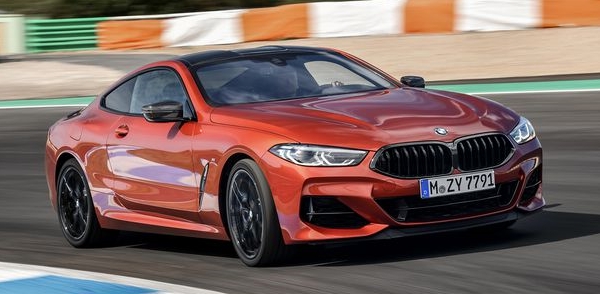
|
|
8-Series
returns, but its mission is as hard to accomplish as ever...
|
|
BMW used the 8-Series
label only once. That was between 1989 and 1998. The original 8-Series
was a large luxury coupe built upon the mechanicals of the 7-Series,
including its 300hp 5-liter V12 motor. During its whole life, it was
hampered by its immense weight and size, failing to deliver a driving
experience worthy of the BMW badge. All 8-Series models but the final,
380hp, 5.6-liter 850CSi were not quick enough to catch our attention.
If not because of its handsome look, we would have forgotten it long
ago. Naturally, it left the world without replacement.
In 2004, BMW resurrected the 6-Series label for its new coupe. The 6er
was built on the component set of the 5-Series thus was considered a
cheaper car than the 8er. It also offered a larger rear seat to widen
its market appeal. However, after 2 generations, the 6-Series label is
retired again. Replacing it is, you guess, the 8-Series label again!
So what is BMW thinking? Maybe we can explain its strange behavior. In
the past decade, sales of coupes and cabriolets have been falling –
more in lower price segments but premium segments are also affected.
This is because many customers turn to SUVs. When car makers offer more
and more SUVs, including some very fast, stylish and sophisticated
ones, fewer and fewer people want conventional coupes. One exception is
the high-end segments. Luxury coupes like Bentley Continental GT, Aston
Martin DB11 and Porsche 911 seem to be unaffected by the fever of SUVs,
because their buyers are wealthy enough to own an SUV and a coupe (and
probably a saloon) simultaneously. This trend drives BMW to move its
coupe upmarket and adopt the 8-Series label again.
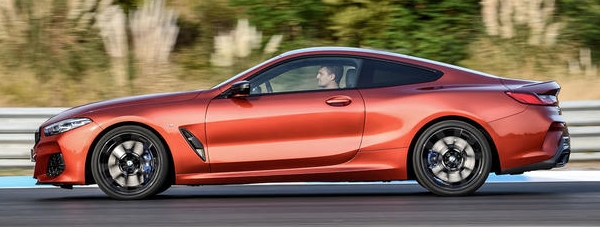
|
|
BMW
positions the car to the GT camp like Aston and Porsche.
|
|
However, that arises another question. The high-end coupe segment is
actually divided into 2 camps: sporty and luxury. We usually call the
sporty one as GT. They include the aforementioned Aston and Porsche,
the front-engined Ferraris, Maserati as well as Lexus LC. Meanwhile,
the luxury camp includes Bentley and Mercedes S-class Coupe, and you
might take 4-door coupes like Audi A7 into account. For the 8-Series
Coupe and Cabriolet, BMW chose the GT camp. For the forthcoming
8-Series Gran Coupe, it takes the other camp. Wise decision.
When the new 8-Series, codenamed G17, debuted in last year’s Concorso
d'Eleganza Villa d'Este in concept form, it was really head-turning.
Very sleek, sharp and interestingly sculpted, it looked so gorgeous
that you could easily confuse it with an Italian design, and I guess
you might be willing to
trade your Aston Martin for it. However, when the car enters
production, it has lost a large part of its charm. Although the
proportion looks similar, some alterations here and there result in a
rather different perception. For example, to accommodate the hot-Vee
twin-turbo V8, the bonnet is raised a little, leading to a bulkier
appearance. The use of 20-inch instead of 21-inch wheels have a similar
effect, visually pushing up the waistline. The nose of the car looks
bulkier than the concept’s, too. Previously, the nose was pointy,
headed by the chromed and 3-dimensional double-kidney grille. The
bonnet, the slim
headlights and bumper elements all flowed seamlessly towards the
grille.
Now in order to save repair costs, the grille is not only converted to
less elegant black elements, but it is flattened and moved back,
leaving the bumper
at the forefront. As a result, the sleek-looking nose becomes
conventional, not much different from other BMW cars. Equally
disappointing, the side windows lose the concept’s chrome surround. The
blade-style taillights of the concept become no more than a poor
approximation with conventional hardware. The minimalist beauty of the
back is also damaged by the black cladding of diffusers. In short,
whatever can
go wrong, it goes wrong.
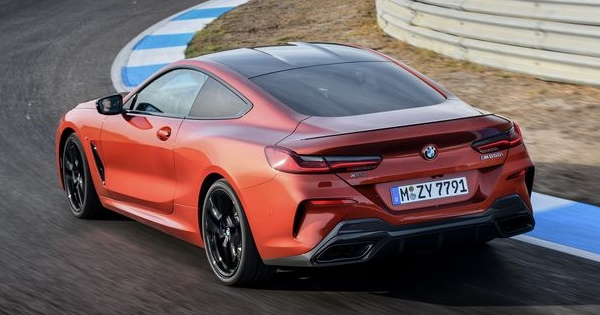 |
|
Styling
in a mess: whatever can go wrong, it goes wrong.
|
|
As a result, I won’t compare the 8-Series to Aston Martin again. Ford
Mustang might be.
Despite the classier name and upgraded market positioning, from
technical point of view, the 8-Series is not much different from its
6-Series predecessor. It is once again derived from the underpinnings
of 5-Series. Not only it is no larger, it is actually a bit shorter
than the old car.
Its
wheelbase is 33mm shorter, too, and its roof is lowered by 28mm. This
is
because a GT is not supposed to take as much care for rear passengers.
Yes, its rear seats are cramped, so cramped that people taller than
5-foot-8 won’t fit. In other words, they are practically child seats.
If anything shows its higher price points – £76,000 for the
entry-level 840d or £100,000 for the M850i – that must be the
interior. While the old 6-Series failed to wash away the smell of
5-Series, the 8-Series has a more upmarket interior. Its use of
stitched leather, large areas of brushed aluminum inserts and even a
glass gear knob breath a luxury ambience. While Aston feels more
special, Bentley and Mercedes feel more luxury, the BMW is modern
and intuitive. It has a TFT instrument (frankly, no more useful
than good old dials) and an excellent iDrive infotainment system that
you can access through either touchscreen, voice commands or iDrive
rotary controller. The seats are mounted very low, just as a GT should,
but they are comfortable for long journeys. To the driver, the 8-Series
is
a much better place to spend time than its predecessor.
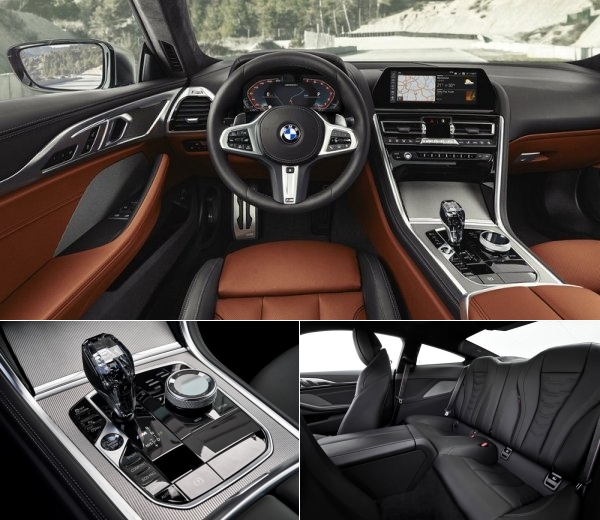
|
|
Brushed
aluminum inserts and glass gear knob breath a luxury ambience.
|
|
Like its platform donor, its chassis is constructed in mostly
high-strength steel but aluminum is used on the engine/suspension
subframes. The bonnet, roof and doors are aluminum, while M850 has CFRP
roof to lower center of gravity.
Double-wishbones and 5-link suspensions are carried over from the
5-Series as well, but retuned for sportier response. They are equipped
with adaptive dampers but not air springs, just like M5. Surprisingly,
BMW decided to fit all models with xDrive as standard. It
engages the front axle only when slippage occurs, so the rear-biased
handling remains. The only penalty is an additional weight of about
65kg.
To enhance agility, 4-wheel steering, active variable-ratio steering
and active
differential are standard on the M850i.
Active anti-roll bars is optional, although it is not strictly
necessary considering the car's low center
of gravity.
As it is so well equipped, the M850i is not going to be light. Rated at
1890kg DIN, it is 130kg heavier than an Aston DB11 V8, or 300kg heftier
than a 911 Turbo! You might say an AMG S63 Coupe is 115kg heavier
still,
but it is a larger and more luxurious car.
Predictably, the 8-Series does not offer as many engine options as BMW
saloons. Its lineup starts from 840d (320hp 3-liter straight-six
turbo diesel) and 840i (3-liter straight-six turbo petrol, to be
unveiled next year). It will be topped by M8 flagship late next year,
but
right now the most potent version is M850i. Unlike the original 850i,
it is powered by a V8 instead of a V12. The 4.4-liter twin-turbo unit
is derived from that of M550i, but it gets a wide range of
modifications, including larger turbos, arc-wire spray cylinder
coating, revised intake air ducts, higher fuel injection pressure,
stronger pistons and con-rods as well as a new crankcase. As a result,
output is lifted from 462 to 530hp, while max. torque is improved from
479 to 553 lbft. That’s half way between the standard BMW V8 and the
M-power V8. Helped further by the excellent ZF 8-speed automatic and
the advantage of xDrive traction, the M850i takes only 3.6 seconds to
sprint from 0-60mph, faster than the rear-drive DB11 V8. However, it
is no faster than the 4-wheel-drive Bentley Continental GT or the new
992 Carrera 4S, while AMG S63 Coupe and Ferrari Portofino claim faster
time. The weakest figure is top speed, as it is strictly regulated to
155mph. Since it is not a full-house M-car, there is no option to raise
the speed limit.
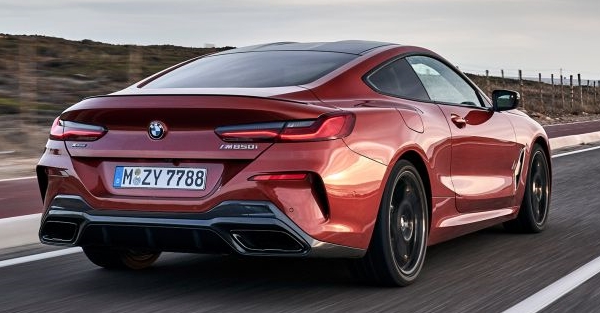
|
|
M850i
sprints from 0-60 in 3.6 seconds.
|
|
On the road, that V8 motor is hard to fault. It has an elastic
mid-range and plenty of top-end grunt. At higher revs, it sounds good,
too, if a little distant if not electronically enhanced by speakers.
Turbo lag is more than desired at lower revs, but there is always
4400c.c. to serve your instant demand. Although it lacks the aural
appeal of AMG (hence Aston) and the passionate soul of Ferrari V8, it
is good enough. Moreover, it does the work of cruising remarkably well,
registering just over 2000 rpm at 100mph, hence a quiet and relaxing
manner.
The M850i serves the role of long-distance GT pretty well. In Comfort
mode, its steering is fingertip-light. Its ride is composed, although
not as supple as the luxury camp coupes. Its noise insulation is better
than Aston Martin.
The original 8er did the cruising work just as fine in its days, but
the new car trumps it by taking handling with equal attention. Cars in
the 1980s and 1990s had few options. If they were big and heavy, they
could never drive like a lightweight sports car. Physics don’t change,
but modern technologies can relieve the pain significantly. With the
help of active differential and rear-wheel steering, the M850 feels
smaller and lighter than it is. Pushing it quickly into a tight corner
may still exhibit too much understeer and reveal its weight, but the
car feels mostly well balanced in other situations. Body roll is
tightly checked by the sportier settings of adaptive dampers. The
xDrive offers dependable traction and grip. The large steel brakes do a
great job to kill speed, and they are strong enough to withstand a few
laps of track abuse.

|
|
With
e-diff and 4WS, it feels smaller and lighter than it is...... but up to
a point.
|
|
Nevertheless, ultimately you won’t choose the M850i as your weapon to
attack a track or a twisty mountain road. Its agility and sharpness is
good to a point. Beyond that, Porsche and Aston win. The tons of
corrective technologies also take communication out of the equation.
The active steering is not only numb, but its varying speed and
weighting could feel unnatural at times.
The world changed a lot since the last 8-Series. Today, we are
surprised that a heavyweight Bentley or S-class Coupe could be so fast
and competent in corners, and a 911 or Aston could be so comfortable
and livable. The new 8-Series tries to be seen as the latter camp, but
its sedan-derived chassis means it is only half-successful. Sitting
between the two camps could be an advantage, but this also means it
fail to please both kinds of buyers. A beautiful shape could be a
game-saver. Unfortunately, it got lost in the road from concept to
production. The BMW 8-Series is by no means a bad car. It is just not
distinctive enough in any areas to deserve recommendation.
|
Verdict:     |
Published
on 16
Feb 2020
|
All rights reserved.
|
|
M8 and M8 Competition
|
|
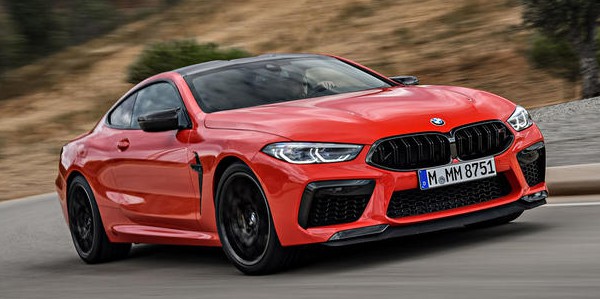
|
|
Fastest
and most expensive in BMW's line-up, this is the performance flagship
of Munich.
|
|
This is the first ever M8,
since the first generation 8-Series was toppled by 850CSi rather than
an M-badge model. It is also the fastest and most expensive BMW on
offer, priced at more than £120,000 before options. Put it
simply, it is the performance
flagship of Munich. Like the lesser M850i, the M8 intends to be a GT in
the same breath of Aston Martin DB11 and Bentley Continental GT, so it
is more performance-oriented than Mercedes S63 Coupe, and more
luxurious than Porsche 911 Turbo or Ferrari Portofino, at least that is
how BMW sees it.
However, motoring journalists might see it the other way: a 2-door M5.
Yes, just like its predecessor M6, despite a classier name and price
tag, the M8
is still derived from the M5. We are not talking of just platform, but
all the important mechanicals underpinning it. This starts from the
S63B44T4 twin-turbo V8 that produces 600 horsepower and 553 lbft of
torque in
standard tune, or 625 hp and the same torque on M8 Competition. Both
sets of figures are exactly the same as the M5 and M5 Competition.
Likewise, power is transferred to the same 8-speed ZF automatic
transmission and M xDrive
4WD system, the latter can be switched to RWD mode should you want to
play power slide on a track. What differs the M8 from M5 is the
short-wheelbase, 2-door, lower and slightly wider body shell, of
course. Its suspensions, which employ the same hardware, the same
adaptive dampers and active anti-roll bars, are set 10mm lower. In
addition to the lower and carbon-fiber roof, the car has a center of
gravity 24mm
lower than that of the sedan. Otherwise, the underpinnings are just the
same. Like the M5 but not the lesser M850i, it skips 4-wheel steering
in pursuit of a more natural steering response. Admittedly, the M
xDrive system makes rear-wheel steering less needed.
Ridiculously, the M8 is actually 10 kg heavier than its 4-door cousin.
Somehow, BMW claims it sprint from rest to 60 mph a tenth quicker,
which is 3.1 seconds for the M8 Competition. Top speed is again
regulated at 190 mph.
Apart from more power, the Competition model gets specific chassis
tuning.
This includes stiffer engine mounts, more negative camber at the front
suspensions and rigid-ball joints at the rear suspension toe links. It
gets also a louder exhaust and lighter forged alloy wheels. However,
the standard steel brakes are just the same, as are the optional
carbon-ceramic brakes.
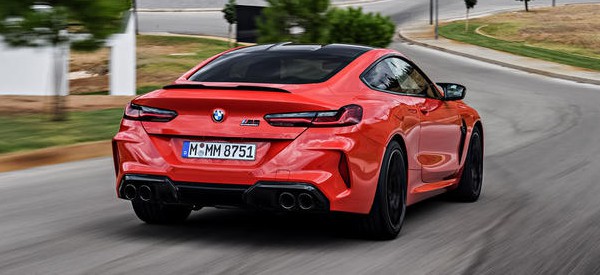
|
|
The
M8 performs just as you expected: a 2-door M5.
|
|
On the road, the M8 performs just as you expected: a 2-door M5. No
faster and no slower, just corner with a bit more control and
precision. On straight, the car is easily faster than the V8 versions
of Aston Martin DB11 and Bentley Continental GT, or even the their
12-cylinder versions, but this is partly down to the traction of
4-wheel drive. Inside the M8’s cabin, the sense of speed is not that
great, because the M-power V8 is not loud enough, even with the sport
exhaust of Competition. For a performance sedan like M5 it is
understandable, but for a high-performance GT it lacks the necessary
sense of occasion.
You may say the same to the looks of M8. The rear end is adventurous
enough, but the front is rather dull. Large double-kidney grilles,
large cooling intakes and those black mesh elements might shout about
performance, but they are just not beautiful. The M8 looks just like
any BMW SUVs compressed by 250 mm vertically. There is nothing
inspiring, nothing catching the heart of an enthusiast. When you are
rivalling Aston, Bentley or even Ferrari, lacking a desirable
appearance is a deadly sin.
Munich might want to claw back some points in the handling and ride
department. However, facing the excellent DB11 and vastly improved
Bentley, the chances are slim. Yes, the M8 hides its weight very well.
Its tremendous grip and traction, quick turn-in and tight body control
give a sure-footed athleticism unimagined by the old M6. In fast bend,
it has understeer kept to the minimum, flies from one bend to another
with precision. Engage rear-drive mode and you can swing its tail out
massively, but still controllably by throttle and steering. The balance
is superb. However, you might say the same to the Bentley, while the
rear-drive DB11 offers more feel from the steering and a greater sense
of agility. The BMW’s sponge brake pedal doesn’t help either.
A GT also needs to be comfortable to travel over long distances. The M8
doesn’t ride with the same supple manner as its rivals. Sharp bumps and
ridges at low speed reveal the limitation of its stiff and short-travel
suspension setup. As for cabin, you might forgive its useless rear
seats, but the cabin design and materials are all too close to the
lesser 8-Series. While ergonomics and functionality are good, sense of
occasion is lacking. The M8 is neither as luxurious as a Bentley nor as
good to drive as an Aston. Although it is priced slightly lower than
both, the gaps are not big enough to attract different kind of buyers.
Most problematic, it feels nothing more than a 2-door coupe version of
M5, which is sold for £25,000 less.
|
Verdict:     |
Published
on 23
Mar 2020
|
All rights reserved.
|
|
8-Series Gran Coupe
|
|
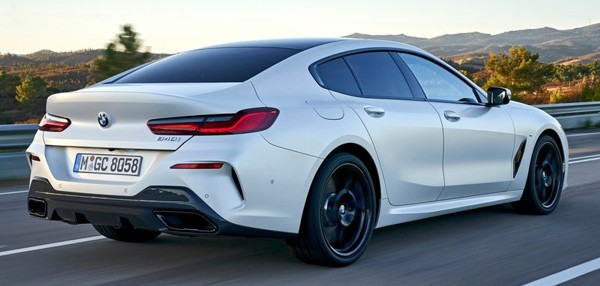
|
|
Benefited
with a 201mm longer wheelbase, its proportion is sleeker and more
balanced...
|
|
Following the introduction
of Gran Coupe, the 8-Series family is finally completed. Like its
6-Series Gran Coupe predecessor, the 4-door luxury coupe is more
likeable than the 2-door Coupe and Cabriolet. Benefited with a 201mm
longer wheelbase, its proportion is sleeker and more balanced,
certainly more beautiful than its 2-door siblings. In the 4-door luxury
coupe world, it is also the better looking one, thanks to a flowing
waistline that is more akin to Italian than German designs. In fact, it
can easily shade any current Maseratis.
With the wheelbase boosted to a massive, limousine-like 3023mm, the
car’s overall length also exceeds 5 meters. This is a large car, not
just seen from the perspective of coupes, but any cars at any price.
Fortunately, it uses space more efficiently than the new Corvette. The
rear seats are truly sized for adults. People up to 6ft 3in can sit
comfortably with plenty of legroom and just enough headroom without
rubbing their heads against the roof liner. That is a surprise, as the
roofline looks steeply raked at the back. The secret is to raise the
roof by 66mm, and hide its tallness by stretching the roofline and
making the car 30mm wider. Nevertheless, don’t expect it to be as
usable as a limousine, because the middle of the rear bench is hard and
its foot well occupied by a large transmission tunnel, so the 5th
passenger can be accommodated, but only for an emergency ride. However,
for 4 passengers, this is a comfortable car to travel along.

|
|
M850i
xDrive is very fast, but it is not as agile as the rear-drive 840i.
|
|
The dashboard and most interior bits are shared with the coupe and
cabriolet, so it feels modern and stylish enough, but lacks the classy
materials and luxurious feel of Mercedes CLS, AMG GT 4-door or Audi A7.
The only flamboyant feature here is the optional crystal shifter knob.
In terms of ergonomics, with the exception of the gimmicky
counter-rotating tachometer, the BMW is generally faultless. The driver
sits low. The center console orients to the driver slightly. All
controls are positioned well. The iDrive works well and there is a
standard head-up display. At the back, the boot is large enough to take
a family’s baggage, although it lacks the convenience of liftback.
Like the 2-door, its monocoque chassis is constructed from a
combination of aluminum and high-strength steel. Most of the body
panels are aluminum sheets, including the doors and roof, but the
latter can be converted to CFRP at costs. The Gran Coupe is around 100
kg heavier than the 2-door coupe, but even the range-topping M8 model
manages to slip under 2 tons (just), so it is a bit lighter than Audi
A7/S/7/RS7 and AMG GT 4-door. However, compared with the equivalent
5-Series, it is up to 200kg heavier. You might question why it takes
considerably more weight and a heftier price tag to accommodate the
same powertrains and offer less interior and luggage space. The answer
is again that thing: for looks. Luxury coupes are always irrational.

|
|
The
rear bench offers remarkable space for 2.
|
|
Predictably, the range of powertrains mirrors that of the Coupe and
Cabriolet. 840i is powered by the B58 3.0-liter straight-6 turbo with
340hp and 369 lbft. It is good for 0-60 in 5.0 or 4.7 seconds
respectively with or without xDrive. Not particularly fast these days,
but in the real world you won’t feel short changed. The point is, BMW’s
classical straight-six is silky smooth, flexible yet eager to rev to
its 7000 rpm redline. It makes nice music, too. The base 840i is really
an appealing choice, one that overshadowing the base versions of A7 and
CLS. It is also better to steer than 840d xDrive, whose diesel engine
is punchy (501 lbft of torque from 1750 rpm!) and superbly refined, but
the extra weight over the front axle dampens the steering response a
little. The 840i is the most agile of the bunch.
The M850i xDrive is faster, of course. With 530 horsepower, the V8
model takes 3.8 seconds to go from rest to 60 mph, quick enough to be a
true M-car a few years back. Nevertheless, it is also heavy, and you
feel that in corner. Adaptive dampers, active anti-roll bars,
electronic locking differential and 4-wheel steering never shrunk off
its weight completely. Perhaps the sportier suspension tuning of M8
Gran Coupe could sharpen things up. The semi-M model feels neither
sporty enough nor as easy going as the lighter, nimbler 840i. Its more
isolated steering feel doesn’t help the impression either. You can save
a lot of cash by taking the base model.

|
|
It
is not afraid to slice into twisty mountain roads, but it also cruises
comfortably on Autobahn.
|
|
Actually, the rear-drive 840i Gran Coupe doesn’t need trick anti-roll
bars or 4-wheel steering to shine. Just take the stiffer M Sport
suspension with 20-inch wheels and fatter tires will make it a keen
handling machine. Its steering is precise and well weighted, with
better steering feel than some of the past efforts, though not to be
confused with a Mazda MX-5. The brakes are powerful and pedal is easy
to modulate. The body control is good with adaptive dampers set to
Sport or Sport+ mode, while Comfort mode will turn it into a perfect
companion for long-distance cruising. The chassis feels rock-solid and
noise insulation is up to very high standards, despite frameless
windows. The wide tires offer bags of grip. At the limit it understeers
gently. To push it to oversteer is virtually impossible on public
roads, but that is expected for a luxury 4-door coupe. The 840i Gran
Coupe is not afraid to slice through twisty mountain roads, where it
feels smaller than its size suggested, but it also cruises comfortably
on Autobahn at triple-digit speeds, just as its name suggested. In
addition to the handsome exterior, this is a highly recommendable car.
Incredibly, although it is better looking and much more usable, the
Gran Coupe is a few thousand dollars cheaper than the equivalent
8-Series 2-door Coupe. It is the best of the bunch, unquestionably.
|
Verdict:     |
|